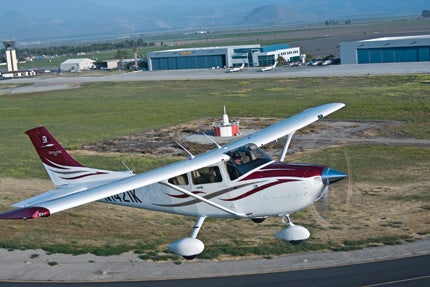 DON'T TAKE ANY CHANCES. Taking off in an airplane with a known equipment deficiency can have disastrous, potentially lethal consequences. |
The other evening, I got a call from a friend who operates a Piper Navajo for his business. He filled me in on what had happened with a flight from his home airport in the Northeast to Miami, Fla. Four employees traveled with him, and the group was due in Miami for a series of meetings. Thunderstorms had taken over Florida, so he had planned an early dinner stop in Savannah, Ga., to give the storms some time to diminish.
When it was time to depart Savannah, he had trouble getting the left engine started, while the right side fired instantly. My friend was surprised by the difficulty: Both engines had been overhauled recently. This was the first trip after the plane had undergone its annual inspection, and there had been no problem starting earlier in the day. The matter became serious when the left engine quit during its magneto check. The right magneto on the engine was fine, but the left one, with the impulse coupler for starting, was dead. That explained the difficulty getting the engine started---something must have happened during the flight to Savannah.
What to do about the flight to Miami? He had his IFR clearance. He still had one good magneto on the left engine and a perfectly good right engine. He had passengers who were anxious to reach their destination. He had a busy schedule the next day. He felt enthusiastic and energetic about flying, but not about trying to round up a mechanic for troubleshooting that could run well into the night. He was facing external and self-imposed pressures, which can lead a pilot to fly with known deficiencies in equipment.
The decision he made was in line with the decision I'd have expected from him: taxi back to the FBO and find out what's going on. When the bad magneto was opened up, assorted parts were loose in the case and it was full of metal shavings. He made a decision to abandon the plane in Savannah, pending a replacement magneto and an inspection to see whether anything else might be going on.
With no airline flights or charters available, he and his employees finished the trip by rented car. He took no chances and didn't become another accident statistic. Others weren't so lucky...
A single-engine Raytheon (Beech) A36 sustained substantial damage during a forced landing at Pahokee, Fla. The commercial pilot, who had been on a personal flight destined for Lakefront Airport in New Orleans, La., wasn't injured. The pilot reported that he found no problems during his preflight inspection. Shortly after taking off from West Palm Beach County Airport, the engine began to "surge," which he reported to ATC; the controller informed the pilot that he was seven miles from the airport. The pilot was able to maintain altitude and land uneventfully.
After examining the engine and the fuel system, the pilot found no problems and departed again. After departure, the landing gear wouldn't retract. He decided to return to the airport. When the plane was nine miles out (at around 2,000 feet), the engine began losing power. The pilot prepared for a forced landing in a field; he unsuccessfully attempted to restart the engine by switching fuel tanks and turning on the fuel-boost pump. While landing, the landing gear "dug in," and the plane rotated onto its nose.
In an engine test supervised by an FAA inspector, the engine wouldn't run on the engine-driven fuel pump. When the electric fuel-boost pump was turned on, the engine started normally and ran without hesitation. The fuel pump was sent to Continental Engines for further examination---it couldn't be rotated by hand. Inspection of the fuel pump vane cavity revealed rust and corrosion. After the cavity was rinsed with a mix of avgas and penetrating oil, the pump was able to rotate. It was reassembled for a functional test, and produced both low- and high-end pressures, as it was supposed to do. The engine had been overhauled two months before the accident. The fuel pump also was supposed to have been overhauled. At the time of the accident, the airplane had flown 12 hours since the annual inspection.
The NTSB determined that the probable cause of this accident was the pilot's decision to depart with a known engine deficiency, which resulted in a loss of power. Contributing to the accident was the loss of engine power due to the failure of the fuel pump.
A twin-engine Cessna 414 was damaged during a runway overrun at Butler County Airport in Butler, Pa. The commercial pilot and three passengers weren't injured. The aircraft had arrived in Butler after a flight from Greenville, S.C.
The pilot told investigators that he overflew the airport in an attempt to determine which way the wind was blowing. He was unable to see the windsock or any other wind indicators.
With the landing gear in the down position, and at 150 knots airspeed, he entered the downwind leg of the traffic pattern for a landing on runway 8. While on the final leg of the approach, the pilot slowed the plane to 130 knots, and further slowed to 120 knots when he crossed the displaced threshold. He then reduced the throttles to idle and reported that the airspeed further decreased to 110 knots about 10 to 20 feet above the runway. The plane touched down smoothly within the first 200 feet of the runway. The pilot began to "work in the brakes," but soon realized they weren't functioning. The plane departed the end of the runway, sped down sloped terrain and stopped after hitting a fence.
The pilot reported that he made the landing with the flaps retracted because they were inoperative. An inspection revealed that the flap circuit breaker was tripped; once reset, any attempt to actuate the flaps resulted in the circuit breaker tripping again. Previously, the pilot had been told that the flap motor needed to be replaced, but he elected not to have the work done. The pilot had subsequently attended recurrency training, where he was instructed that the flaps "were not required." Another individual who had flown the airplane advised the pilot that the brakes were "spongy" and that maximum braking effort couldn't be obtained easily.
The C-414's POH indicated that landings on hard-surface runways should be done with 45 degrees of flaps from a 107 mph (92-knot) indicated airspeed approach, using as little power as practicable.
The NTSB determined that the probable cause of this accident was the pilot's decision to conduct the flight with a known equipment deficiency.
A single-engine Cessna 182G impacted a levee during a forced landing after a loss of engine power near Tuckerman, Ark. The commercial pilot sustained minor injuries; his passenger was seriously injured. Investigators found no fuel in the airplane's tanks, but there was blue streaking from the left fuel tank's filler port to the trailing edge of the wing. The flight had departed from Sherman Army Air Field in Fort Leavenworth, Kans., and was headed for Newport, Ark.
Earlier in the day, the pilot made a fuel stop at Harrisonville, Mo. He told a lineman that the locking tabs were broken from the cap on the left main fuel tank. The lineman suggested that the pilot purchase a new fuel cap, but he didn't do so. The plane was serviced with 46.39 gallons of 100LL fuel, and it departed for the 15-minute flight to Fort Leavenworth. After landing, the pilot purchased 27 gallons of 100LL fuel. Ground personnel reported to the pilot that the left main tank had a "bad fuel leak," and the pilot stated that the cap was broken. The pilot was offered duct tape, and he taped the left main fuel tank filler cap with about two square feet of duct tape.
The NTSB determined that the probable cause of this accident was the pilot's operation of the airplane with a known deficiency, which resulted in fuel leakage and a loss of engine power due to fuel exhaustion.
Peter Katz is editor and publisher of NTSB Reporter, an independent monthly update on aircraft accident investigations and other NTSB news. To subscribe, write to: NTSB Reporter, Subscription Dept., P.O. Box 831, White Plains, NY 10602-0831.

Subscribe to Our Newsletter
Get the latest Plane & Pilot Magazine stories delivered directly to your inbox






